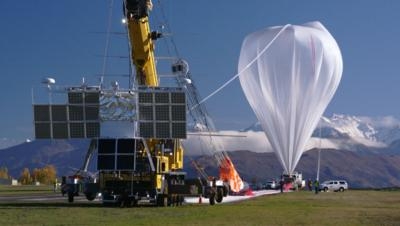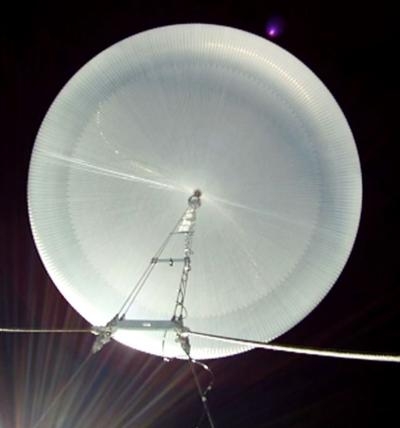Third Consecutive Year For Experiments There
For a third consecutive year, NASA is returning to Wanaka, New Zealand, to launch a long-duration, heavy-lift super pressure balloon (SPB) into one of the most dynamic and severe flight regimes inside the Earth's atmosphere.

After launch, planned for the late March/early April timeframe, the 18.8-million-cubic-foot SPB will ascend to an altitude of 110,000 feet where the stratospheric winds will propel it at speeds up to and exceeding 100 knots through the heating and cooling of the day-night cycle on a weeks-long journey around the southern hemisphere.
"We are excited to return to Wanaka, which has served as an ideal location for launching our SPB test flights," said Debbie Fairbrother, NASA's Balloon Program Office chief. "With 32 days of flight in 2015 and 46 days in 2016, we hope to build on the successes and lessons learned of our past campaigns as we seek even longer duration flights at mid-latitudes."
Members of NASA's Columbia Scientific Balloon Facility (CSBF) team are set to arrive in Wanaka in early February 2017 to begin launch preparations. "For some of the crew this is their third visit; we’re excited to once again be part of the Wanaka community," said Fairbrother. “We appreciate the opportunity to work with Airways New Zealand, the Queenstown Lakes District Council, and the Wanaka Airport team to ensure yet another successful launch from Wanaka.”
While the ongoing testing and development of the SPB is the primary focus of this year's mission, the NASA Scientific Balloon Team is flying the University of Chicago's Extreme Universe Space Observatory (EUSO-SPB) payload as a mission of opportunity. The EUSO-SPB team’s arrival in Wanaka will coincide with the CSBF team arrival.

EUSO-SPB is a high-energy cosmic ray particle astrophysics payload that will test a fluorescence detector and its supporting technologies under the severe operating conditions of the stratosphere. This suborbital flight is a precursor for a mission being planned to launch the EUSO telescope to and install it on the International Space Station (ISS).
"Along with providing a low-cost alternative for certain types of science payloads that otherwise would need to launch into orbit around the Earth, NASA's scientific balloons also support technology demonstrations, like EUSO-SPB, as a means to validate the technologies in an environment similar to space," said Fairbrother.
New to the 2017 campaign will be the much-anticipated construction of a dedicated balloon launch pad on the northeast side of the Wanaka Airport. This new pad, a 600-metre in diameter large gravel semi-circle, will enable NASA's balloon launch operations to run seamlessly alongside other airport operations and tenants on launch day. NASA will still operate out of a leased hangar onsite.
NASA's SPB is a large structure, about the size of the Forsyth-Barr Stadium in Dunedin, New Zealand, when fully inflated. The balloon is made from polyethylene film, which is similar in appearance and thickness to the type used for sandwich bags, but stronger and more durable.
As a pressurized flight vehicle, the SPB is designed to float at a constant density altitude despite the heating and cooling of the day-night cycle. This pressurization, coupled with the stratospheric conditions in the southern hemisphere, enable long-duration flights. The science and engineering communities have previously identified long-duration balloon flights at constant altitudes as playing an important role in providing inexpensive access to the near-space environment for science and technology. The current record for a NASA super pressure balloon flight is 54 days.
NASA’s Wallops Flight Facility in Virginia manages the agency’s scientific balloon flight program with 10 to 15 flights each year from launch sites worldwide. Orbital ATK, which operates NASA’s Columbia Scientific Balloon Facility, provides mission planning, engineering services and field operations for NASA’s scientific balloon program. The CSBF team has launched more than 1,700 scientific balloons in its over 35 years of operation.
(Images provided with NASA news release)
 Unfortunate... ANN/SportPlane Resource Guide Adds To Cautionary Advisories
Unfortunate... ANN/SportPlane Resource Guide Adds To Cautionary Advisories ANN FAQ: Turn On Post Notifications
ANN FAQ: Turn On Post Notifications ANN's Daily Aero-Term (04.29.24): Visual Approach Slope Indicator (VASI)
ANN's Daily Aero-Term (04.29.24): Visual Approach Slope Indicator (VASI) ANN's Daily Aero-Term (04.28.24): Airport Marking Aids
ANN's Daily Aero-Term (04.28.24): Airport Marking Aids ANN's Daily Aero-Linx (04.28.24)
ANN's Daily Aero-Linx (04.28.24)




